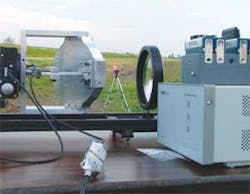OPTICAL DATA STORAGE: Polarization and wavelength-resolved recording comes of age

The battle in data density for optical storage has seen a leap through multiple dimensions. Researchers at the Swinburne University of Technology (Hawthorne, Australia) have demonstrated a technique to optically read and write information in multilayer stacks that corresponds to a data density of 1.6 terabytes on a standard DVD-size disc.
The “5-D” approach they describe works by encoding information in three spatial dimensions through the multilayer stack, as well as encoding data with different input wavelengths and polarizations.
The third spatial dimension is well known as a place to stack up extra data density—high-end writers for Blu-Ray discs put the data on two layers. Other approaches exploiting data storage through the encoding of wavelength or polarization have been demonstrated.1, 2 But James Chon and Min Gu’s work is the first to show a system that uses all five of these different dimensions to record and read out data. The trick, they say, is in using gold nanorods as the recording medium.
“Min Gu is a world-leading expert in optical data storage and nonlinear microscopy,” said James Chon. “When I joined his group in 2001, he was looking for ways to overcome the data-density limit imposed by the diffraction limit of light. I had experience with gold nanoparticles in my Ph.D. and suggested that if nanorods could be used as a recording medium, additional dimensions in color and polarization could be possible.”
Three lengths of nanorod
Each recording layer was made up of gold nanorods in a distribution of three different lengths. A homogeneous mixture of the nanorod sets was suspended in polyvinyl alcohol and spin-coated onto glass coverslips 10 µm thick. Ten of these were placed in a stack for the multilayer “blank disc.”
The write process is accomplished by using a commercial tunable Ti:sapphire oscillator focused through a high-numerical-aperture lens in a home-built microscope. The nanorods have a threshold temperature at which they melt and reform as much shorter rods or spheres. The degree to which this photothermal reshaping occurs is dependent on the input wavelength and its alignment relative to the incoming polarization. Therefore, individual rods can be selected out of a large number present in the focal volume; only those that are of an appropriate length and orientation are converted into spheres, representing a depleted local population of rods corresponding to those parameters: a data point.
Moreover, the sharp cutoff of the photothermal reaction in combination with the tight focusing means that individual layers in the stack can be addressed. “This is in stark contrast to single-photon recording by photobleaching or photoisomerization, where the out-of-focus laser light would still induce recording,” the authors say.
Two-photon-absorption readout
Readout is accomplished by using the same microscope with the laser attenuated by three orders of magnitude; the laser induces two-photon luminescence that is routed into a photomultiplier. Surprisingly, the team found that their nanorods had a phenomenally high two-photon absorption cross-section—three to four orders of magnitude higher than the best nonlinear dyes. “This obviously helps in clearer readout of the recorded patterns,” Chon says.
Using two polarizations and three wavelengths to write and read the data, the researchers got a data density of 1.1 terabits per cubic centimeter, equivalent to 1.6 terabytes per disc.3 But by using three polarizations and four wavelengths, they estimate they can achieve a density of 7.7 terabits per cubic centimeter.
And as for the prospects for commercialization? “The optical system to record and read 5-D is very similar to the current DVD system,” says Dr. Chon. “Industrial-scale production of a compact system is possible. One issue that we face is the need for high-power lasers, which will depend on the progress of the laser community; if a high-power, modular laser system is available, it can be incorporated into the system easily.”
The team estimates that material costs for a standard DVD-size disc would be around five cents. But there is a push toward more-robust silver nanorods for the purpose, which would bring that cost down to a hundredth of that. The group is already working with Samsung (Seoul, Korea) to develop a commercial drive that could read discs manufactured with the process, and are trying to synthesize shorter silver nanorods that will allow them to increase the physical density of nanorods in the matrix, and therefore data density in the resulting discs.
“Our challenge is to increase the data capacity up to a petabyte per disc,” Chon says.
REFERENCES
- Pham et al., Adv. Mater. 16, p. 516 (2004).
- Li et al., Opt. Lett. 32, p. 277 (2007).
- Zijlstra et al., Nature 459, p. 410 (2009).
D. Jason Palmer | Freelance writer
D. Jason Palmer is a freelance writer based in Florence, Italy.